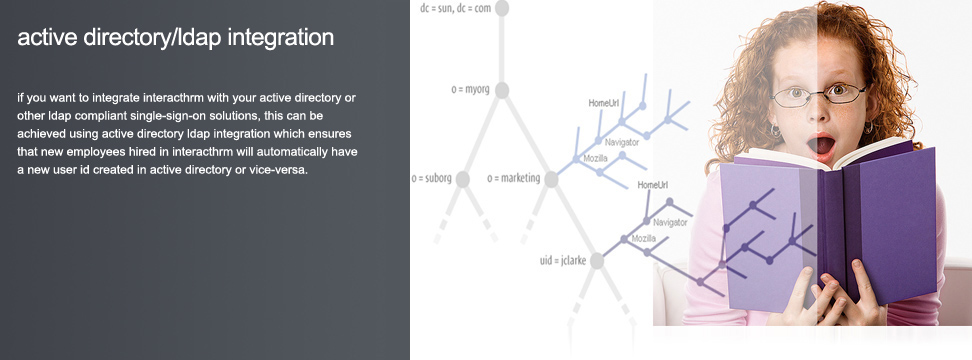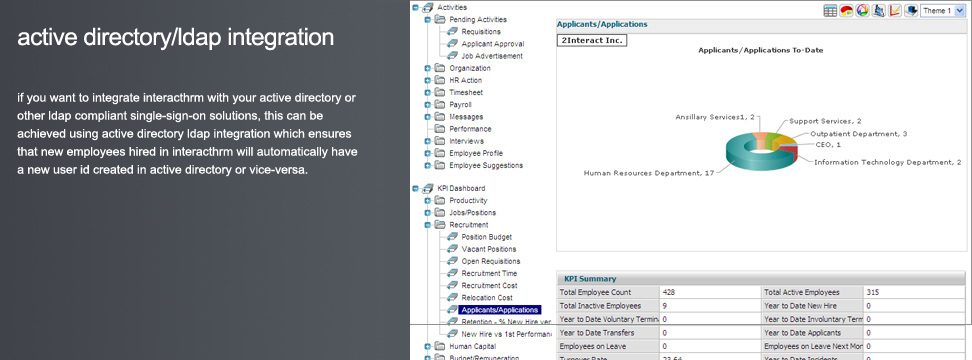The Active Directory (AD)/LDAP Integration module in Interact HRMS provides seamless integration with Active Directory and other LDAP-Compliant Single-Sign-On (SSO) Solutions, enabling automatic user account synchronization between Interact HRMS and Active Directory. This module ensures that when new employees are hired in Interact HRMS, a corresponding User ID is automatically created in Active Directory, or vice-versa. By eliminating the need for manual account creation and updates, this integration supports streamlined onboarding and offboarding processes, strengthens security, and enhances IT and HR efficiency.
This module is ideal for organizations that use AD/LDAP for user authentication, as it allows HR and IT teams to synchronize employee data across systems, improving consistency and reducing administrative tasks. With Active Directory/LDAP integration, Interact HRMS provides an efficient way to manage access control, maintain up-to-date user credentials, and support unified user account management across the organization.
Automatic User Synchronization for Streamlined Onboarding and Offboarding
The Active Directory/LDAP Integration module enables Automatic User Synchronization, creating new Active Directory accounts for new hires in Interact HRMS and deactivating accounts for terminated employees. This automated synchronization reduces administrative effort, ensuring that HR and IT systems are aligned and up-to-date.
For example, when a new employee joins the organization and their record is created in Interact HRMS, the integration automatically generates a corresponding Active Directory account, eliminating the need for manual user provisioning. Similarly, when an employee leaves the organization, their HRMS record can trigger the deactivation of their AD account, maintaining access control without additional steps.
Single Sign-On Support for Simplified User Access
This integration provides Single Sign-On (SSO) Support, allowing employees to log into Interact HRMS using their AD or LDAP credentials. With SSO, employees use a single set of credentials for multiple applications, streamlining access and reducing the need for multiple logins. This feature enhances user convenience, reduces password fatigue, and strengthens security through centralized authentication.
For instance, employees who are already logged into their organization’s network can access Interact HRMS without needing a separate login, improving their user experience and supporting efficient workflows.
Enhanced Security Through Centralized Authentication
The integration with AD/LDAP strengthens Security by centralizing user authentication and enforcing consistent security policies. Since user accounts are managed through a single directory, administrators can implement uniform Password Policies, Access Control, and Multi-Factor Authentication (MFA) across all connected systems, ensuring compliance with organizational security standards.
For example, if the organization requires periodic password changes, this policy will automatically apply to Interact HRMS users through their Active Directory credentials, enhancing security while simplifying account management.
Bidirectional Synchronization for Real-Time Data Consistency
The module supports Bidirectional Synchronization, meaning that changes in either Interact HRMS or Active Directory will automatically update the corresponding system. This bidirectional functionality maintains data consistency and prevents discrepancies in user information, supporting accurate and up-to-date employee records across the organization.
For instance, if an employee’s department or role is updated in Interact HRMS, this change will be reflected in Active Directory, ensuring that permissions and access levels align with the employee’s current responsibilities.
Reduced IT Administrative Burden
By automating user account creation and updates, the Active Directory/LDAP Integration module reduces the IT Administrative Burden associated with manual user management. With AD integration, IT teams no longer need to manually provision or deactivate user accounts, allowing them to focus on other critical tasks.
For example, when HR finalizes the hiring process for a new employee, the integration handles AD account creation without requiring IT intervention, simplifying onboarding and ensuring immediate access to necessary systems.
Audit Trails and Activity Tracking for Compliance
The module includes Audit Trails and Activity Tracking capabilities, recording all synchronization events and changes between Interact HRMS and Active Directory. This feature supports compliance by documenting account creation, updates, and deactivation activities, providing a transparent record for audits or internal reviews.
For instance, if an auditor requires a log of user accounts added or deactivated, HR and IT can retrieve a detailed record of all AD-related activities, ensuring compliance with organizational policies and regulatory requirements.
Customizable Synchronization Rules for Targeted Integration
The integration allows administrators to define Customizable Synchronization Rules, enabling control over which employee data fields are synchronized and which users are affected. This customization supports targeted integration, ensuring that only relevant information is shared between Interact HRMS and Active Directory.
For example, an organization may only want to synchronize user accounts for certain departments or job roles, excluding temporary or part-time employees. These rules ensure that the integration meets specific business needs while optimizing system performance.
General Features of the Active Directory/LDAP Integration Module
- Automatic User Synchronization: Automate AD account creation, updates, and deactivation for Interact HRMS employees.
- Single Sign-On Support: Enable users to log into Interact HRMS with AD or LDAP credentials for simplified access.
- Centralized Security: Apply consistent security policies across systems through centralized authentication.
- Bidirectional Synchronization: Ensure data consistency by updating changes in both Interact HRMS and Active Directory.
- Reduced IT Workload: Automate user provisioning to free up IT resources for other tasks.
- Audit Trails: Track synchronization events for compliance and accountability.
- Customizable Synchronization Rules: Define specific data fields and user groups for targeted integration.
Summary: Interact HRMS Active Directory/LDAP Integration Module
The Interact HRMS Active Directory/LDAP Integration module provides a robust solution for organizations that use AD or LDAP for user authentication, enhancing security, efficiency, and data consistency. Key benefits include:
- Automated User Management: Automatically create and deactivate AD accounts, supporting efficient onboarding and offboarding.
- Seamless Single Sign-On Access: Simplify user login by allowing employees to use existing AD credentials.
- Strengthened Security Through Centralized Authentication: Enforce consistent password policies and security protocols across systems.
- Bidirectional Synchronization for Data Accuracy: Maintain real-time updates between HRMS and AD, ensuring accurate user information.
- Reduced Administrative Burden on IT: Automate routine account management tasks, freeing IT resources for strategic projects.
- Audit Trails for Compliance Assurance: Track all account-related actions to support audits and ensure regulatory compliance.
- Customizable Synchronization Options: Tailor synchronization rules to meet organizational requirements.
By integrating Active Directory or LDAP with Interact HRMS, the module enhances operational efficiency, supports secure access management, and ensures up-to-date and consistent employee data across systems. This centralized approach to user account management simplifies HR and IT collaboration, promoting a streamlined and secure HR environment.


